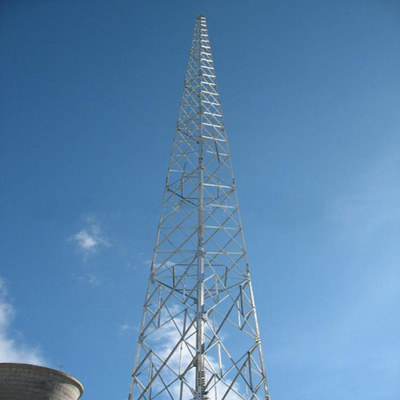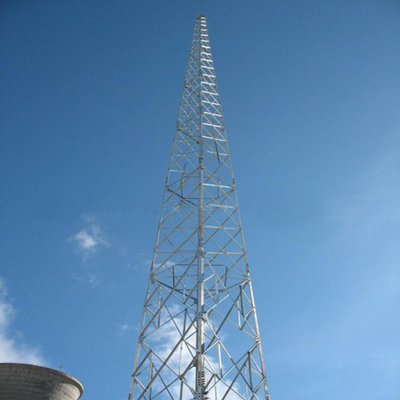-
Telecom Steel Tower
-
Transmission Steel Tower
-
Camouflaged Cell Towers
-
Galvanised Street Light Pole
-
Lattice Steel Towers
-
Solar Panel Support Structure
-
Galvanized Steel Structures
-
Traffic Signal Light Pole
-
Steel Tubular Pole
-
Rooftop Antenna Tower
-
High Mast Light Tower
-
Guyed Wire Towers
-
CCTV Camera Poles
45m 4 Legs Angle Lattice Steel Tower Wind Load 160kmph For Mobile Antenna

Contact me for free samples and coupons.
Whatsapp:0086 18588475571
Wechat: 0086 18588475571
Skype: sales10@aixton.com
If you have any concern, we provide 24-hour online help.
x| Product Name | 45m 4 Legs Angle Lattice Steel Tower Mobile Antenna | Surface Treatment | Hot-dip Galvanized |
|---|---|---|---|
| Height | 45m | Material | Angle Steel Plates, Flat Steel Plate, Bolts And Nuts |
| Certification | ISO9001:2008 SGS COC | Wind Load | 160km/h |
| Design Loading | As Per Requirement And Specification By Clients Worldwide. | Tower Type | Tube Towers, Mono Pole Tower, Angle Towers |
| Design Of Pole | Against Earthquake Of 8 Grade | Application | Highway, Freeway, Airport ,seaport,plaza,stadium ,square,highway,street Way Etc |
| Highlight | 4 Legs Angle Lattice Steel Tower,45m Lattice Steel Tower,Telecom Steel Tower Wind Load 160kmph |
||
45m 4 Legs Angle Lattice Steel Tower Wind Load 160kmph For Mobile Antenna
Specification of 4 Legs steel tower:
| Material | Tubular Steel, Angle steel plates, flat steel plate |
| Steel Type | Weldable low carbon structural steel |
| Steel Grade | GB Q235, Q345, BS 4360, ASTM A36 etc. |
| Yield Strength | Fy≥235MPa |
| Tensile Strength | Fu≥400MPa |
| Elongation | σ≥20% |
| Surface Finish | Hot dip galvanization |
| Galvanized layer | T≥65μm |
| Height | 20m to 100m, customized to requests |
| Design | 4 legs self-supporting or free standing lattice tower |
| Structure | 1 to 5 platforms, each platform comes with 4 to 6 brackets for mounting antennas or specified number of brackets for mounting antennas, microwaves, RRUs and other devices. |
| Supply mode | CKD(Complete Knocked Down), SKD(Semi-Knocked Down), DKD(Direct Knocked Down) |
| Fixing/Fastening | Bolts and nuts, connecting plates |
| Configuration | Foundations/anchoring bolts, tower sections, 1-5 platforms (optional), mounting brackets, ladder, anti-fall safety system, lightning rod, earthing plate etc. |
| Wind Load | 0.35-1.0kN/sqm |
| Lifespan | 20-50 years |
| Warranty | 5 years |
| Applications | GSM/3G/4G/5G/FM radio antennas, microwaves, telecom stations. |
The aforementioned parts help determine just how far a cell tower can be a from a cell phone while still able to pick up its signal. That distance is determined by the connecting technology, landscape features (hills, trees and buildings), the power of the tower’s transmitter, the size of the cellphone network and the network’s design capacity.
What’s interesting is that a cell tower will sometimes have their transmitter seat to a lower power on purpose to ensure it doesn’t interfere with neighboring cells.
But even with all of those factors, the typical cell tower can provide service up to 45 miles away. That’s quite impressive! Let’s take a closer look at what various components affect a cell tower’s range and effectiveness.
What affects a cell tower’s range?
The range of a cell tower is not a fixed figure. That’s because there are so many variables when it comes to the range in which a cell tower connects a mobile device. The most common variables include:
- How hight the antenna is over the surrounding landscape.
- The frequency of the signal in use.
- The rated power of the transmitter.
- The directional characteristics of the antenna array on the site.
- Nearby buildings and vegetation absorbing and reflecting radio energy.
- The local geographical or regulatory factors and weather conditions.
Cell towers are often built in areas with high population densities. That’s because these cities have the most potential cell phone users. For that reason, you’ll often find cell towers “overlapping” in more crowded areas. This helps to avoid interference problems.
If you find yourself wondering why you don’t have a signal on your cell phone, it could be because you’re too far from a tower or because the cell phone signal has been decreased by hills, large buildings or other structures. You may also lose your signal if a lot of people are attempting to use the cell tower at the same time. That often leads to calls getting dropped.
While driving, your phone can switch from one cell tower to the next mid-conversation. As you continue your journey, the cell phone will pick the strongest signal and release the weaker cell tower, making it available to another caller.




